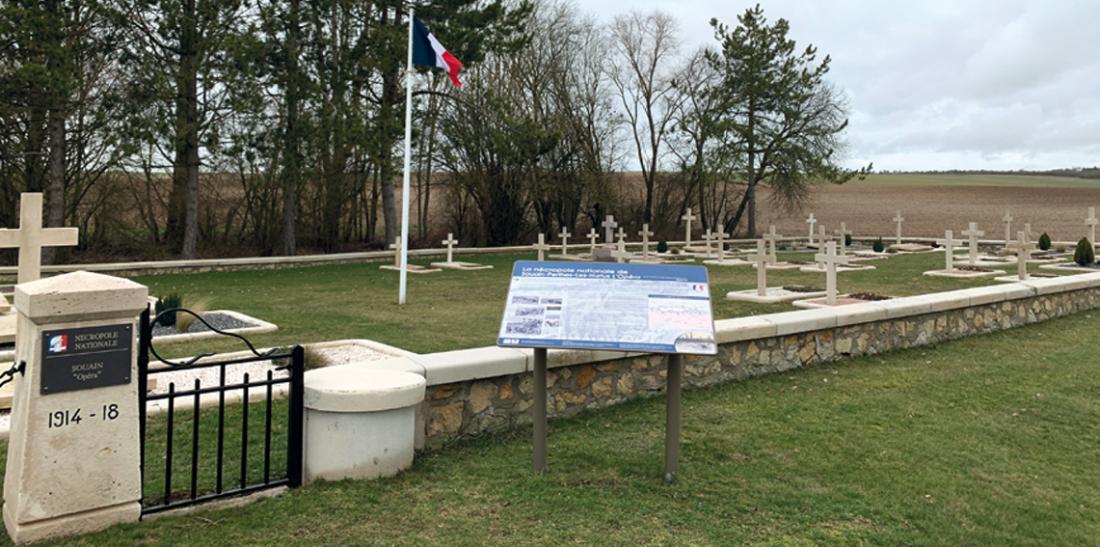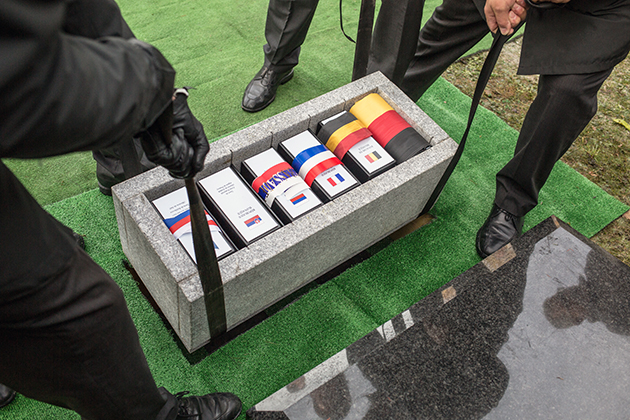Attaching value to remembrance heritage in France

In France, besides the upkeep of the war graves, the Ministry of the Armed Forces has for a number of years now had an ambitious policy in place to renovate the 275 national cemeteries, 2 200 military plots across the country and the 1 000 French military burial places in nearly 80 countries, emblematic sites for honouring and preserving memory.
At the time of the First World War centenary, these burial sites were the focus of everyone’s attention. Indeed, French people discovered fresh interest in remembrance tourism, which saw outstanding growth that has kept up momentum today. Aware of the value of these cemeteries in terms of remembrance and tourism heritage, visitors expect them to be treated with the respect the State owes to those who died for France.
Restoring the cemeteries according to a landscaping charter
In this context, the Ministry of the Armed Forces Directorate for Heritage, Remembrance and Archives (DPMA), in partnership with its operators, the National Office for Veterans and Victims of War (ONAC-VG) in France, Algeria and Morocco, the overseas armed forces commissioners and the diplomatic posts in other countries (except Algeria and Morocco), has put in place an unprecedented renovation policy for the remembrance sites. Between 2011 and 2019, nearly 20% of national cemeteries were renovated, as well as the vast majority of French overseas military cemeteries. For the period 2020-2025, it was decided that this process should continue, with emphasis on preserving the authenticity of the sites and improving visitor welcome.
As well as the traditional aims of cemetery upkeep are additional concerns to respond to the challenges of sustainable development and biodiversity conservation. To that end, France has developed alternative, environmentally friendly restoration methods. With the support of State-approved landscape designers and architects, a landscaping charter was drawn up for the cemeteries. The charter aims to make the sites more attractive through improvements to information, building and landscape design, in order to create “remembrance parks”, sites of exemplary environmental and heritage value that are in keeping with their remembrance setting and could be incorporated into existing remembrance tourism trails.
Remembering in situ
The military cemeteries and burial sites attract hundreds of thousands of visitors every year; the site of Douaumont (Meuse) alone receives 200 000 visitors each year, and that of Notre-Dame de Lorette (Pas-de-Calais) more than 300 000.
The renovation of this remembrance heritage is a means for the Ministry of the Armed Forces to tie these sites to remembrance tourism. Its multiple actions have national scope, but may also draw on local dynamics. For the overseas military cemeteries, the ministry encourages the renovation of sites of shared remembrance, which contributes to raising France’s profile abroad. Every year, a programme of activities is put in place, linked to the commemoration of key dates in contemporary conflicts involving France. In 2021, the priority actions involving the cemeteries are linked to the 150th anniversary of the Franco-Prussian War (2020-21) and the 80th anniversary of the Second World War (2019-25).
As part of the First World War centenary, around a hundred ceremonies were held at the national cemeteries across the country, making these remembrance sites the physical link between present-day society honouring the dead, and the dead themselves who are buried there.
For example, on 3 November 2018, in an international ceremony presided over by regional government officials and the mayor of Vouziers (Ardennes), representatives of Germany, the Czech Republic, Slovakia, Belgium and Russia unveiled a stela containing soil from those six countries, dedicated to the First World War soldiers buried in Vouziers cemetery.
Caskets containing soil from the native countries of the soldiers killed in the Ardennes are laid during an international ceremony at Vouziers cemetery, 3 November 2018.
© Irina Kalashnikova/Sputnik/Sputnik via AFP
On 10 November 2018, to mark the centenary of the Armistice, illuminations were installed in the cemeteries most emblematic of the First World War, for an evening vigil which attracted scores of people. To celebrate the 150th anniversary of the Franco-Prussian War, on 1 September 2020 a ceremony was held at Mars-la-Tour cemetery (Meurthe-et-Moselle) in honour of the French soldiers, and another, international one, with German officials in attendance, in the hall of remembrance at the Gravelotte remembrance site (Moselle). These ceremonies shine a spotlight on the remembrance value of these iconic sites.
Including burial sites in remembrance tourism
With a view to facilitating the passing-on of memory, the ministry invests in developing the information on its sites. Between 2014 and 2019, the 275 military cemeteries were equipped with historical information panels. Between 2020 and 2024, nearly 300 panels will be installed in the most important military plots.
The same will happen overseas. The French military cemetery of Korçë, in Albania, and the military cemetery of Bel Air, in Senegal, will soon be equipped with historical and tourism information panels. In North Macedonia, an interpretation centre was opened in 2018 in the French military cemetery of Bitola, where more than 10 000 soldiers killed in the First World War are buried. In April 2021, realising one part of the two countries’ shared memory, a room was inaugurated in the museum of Sabang, Indonesia, in honour of French lieutenant Jacques Carissan, who was killed in action on 28 October 1914 aboard the French destroyer Le Mousquet, in the Battle of Penang, and buried on Weh Island, north of Sumatra.
Another target which France has set itself is to better integrate the cemeteries in remembrance trails. A consultation was launched in 2021 on improvements to road signs. Similarly, tourist leaflets about the most important cemeteries are currently being produced by ONAC-VG, and will shortly be available at local tourist offices and nearby remembrance sites.
Meanwhile, the DPMA has introduced innovative tools, such as 360° films, to enable new audiences to discover the cemeteries. Three films have already been made, so that visitors, in particular those traditionally excluded, can have an immersive experience at the heart of the cemeteries of Notre Dame de Lorette, Douaumont and the Bayonet Trench, as well as those of Vercors. In preparation for the 150th anniversary of the Franco-Prussian War, a web series was broadcast in 2021 presenting the war’s key remembrance sites, in particular the Franco-German cemetery at Gravelotte. The series is available on multimedia platforms and is intended for use as a teaching aid by school history teachers to raise young people’s awareness of this heritage. Currently, the Ministry of the Armed Forces is supporting an original initiative of national and international scope, which by 2023 plans to create a “peace trail”, comprised of gardens created at remembrance sites from Ypres in Belgium, through the main French departments of the front, all the way to the Swiss border. Thirty-five gardens are planned, including a dozen in military cemeteries. The idea is to attract lovers of plants and gardens to take an interest in the remembrance sites.
Finally, the proposed nomination of the First World War cemeteries and memorial sites for inclusion on the UNESCO World Heritage List – including nearly 50 military cemeteries – the conclusions of which have been put back to 2022, ought to encourage a diversified audience to discover the burial sites.


